This post may contain affiliate links. We may receive a small commission, at no cost to you, if you make a purchase. Read Disclosure.
If you’re planning an epic adventure across South America and are lucky enough to visit Brazil and Argentina, then you must make sure to visit Iguazu Falls in South America.
This is one of the seven natural wonders of the world, and it’s easy to see why! It’s more than waterfall, but a natural wonder I think should top everyone’s must see list!
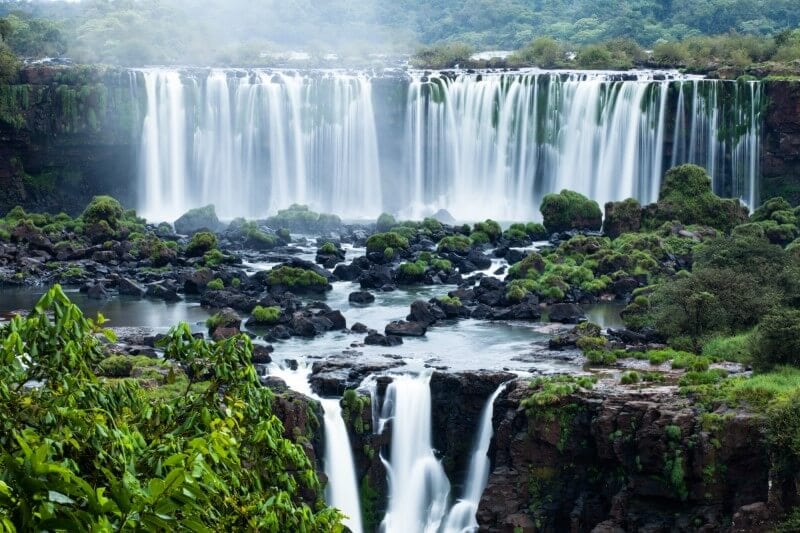
Iguazu falls (also referred to as Iguassu Falls or Iguacu Falls) is a huge waterfall between Brazil and Argentina on the Iguazu River and surrouned by the Iguazú National Park.
Victoria Falls may be the largest waterfall in the world, and Niagara Falls the most famous, but Iguazu is by far the most beautiful.
The only problem with a waterfall that sits on the border of two countries is…which side of the Iguazu Falls is better?
The equal opportunist in me would say, both sides are great! That’s the honest truth. You should definitely see both if you can.
Having had the chance to visit both sides from Foz do Iguacu (Brazil) and Parque Nacional in Puerto Iguazu (Argentina), I know which is my favorite.
But we are not all blessed with the luxury of seeing both, so this is for those who can’t decide between Iguazu Falls Brazil or Argentina.
I have compared my experience of visiting Iguazu Falls on both sides of the fence, so you can make a better informed decision about which side to visit.
- Quick Facts about Iguazu Falls
- Which Has The Best Iguazu Falls View?
- Which Has Better Access to Iguazu Falls?
- Which Is Better for Wildlife at Iguaçu National Park?
- Which Is Better for Things to Do at Iguazu Falls
- Park Entrance Fees
- Other Things to Consider About Visiting Iguazu Falls
- The Verdict: Which side of Iguazu Falls is Better?
- More South America Travel Tips
Quick Facts about Iguazu Falls
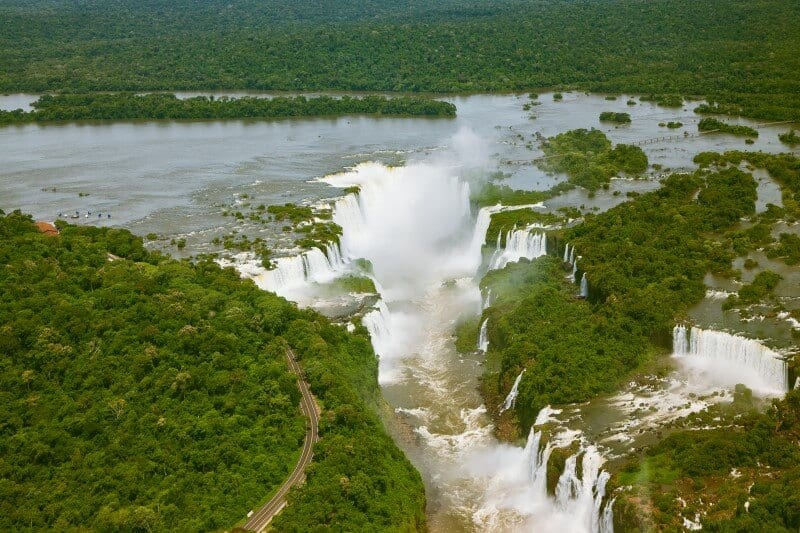
But first, let’s quickly introduce these falls to you. I’m surprised that I never heard much about the falls prior to our South America trip and the truth is, Iguazu doesn’t get the same hype as other waterfalls such as Niagara or Victoria.
Well, that’s all about to change. Here are some facts you may not know about Iguazu Falls:
- Taller than Niagara; wider than Victoria
- Iguazu translated from the native Indian language means “Big Water“
- Greatest average annual flow of water in the world
- Featured in the movie Mr. Magoo and Indiana Jones and The Kingdom of the Crystal Skull
- They are owned by the two UNESCO World Heritage sites; Iguazú National Park in Argentina and Iguaçu National Park in Brazil.
- They are the result of a volcanic eruption which left a huge crack in the earth.
- There are 275 waterfalls of the Iguazu River and stretch for 2.7 km (1.67 miles)
Arguably the most beautiful natural wonders I’ve ever seen. So you’re probably wondering..
Which Has The Best Iguazu Falls View?
The best view is determined by how you prefer to see it. By land or atop? To help you decide, here’s what you can expect to see on the Brazil and Argentina sides…
Iguazu Falls in Brazil: Panoramic View of Iguazu Falls

For a panoramic view, picture perfect postcard of the falls, head on over to the Iguazu Falls in Brazil.
Consisting of a network of 275 waterfalls spanning an area of 3 km wide, virtually every angle, a 360 view, is incredibly breathtaking.
It’s impossible to take a bad photo here.
Iguazu Falls in Argentina: Aerial View of Iguazu Falls
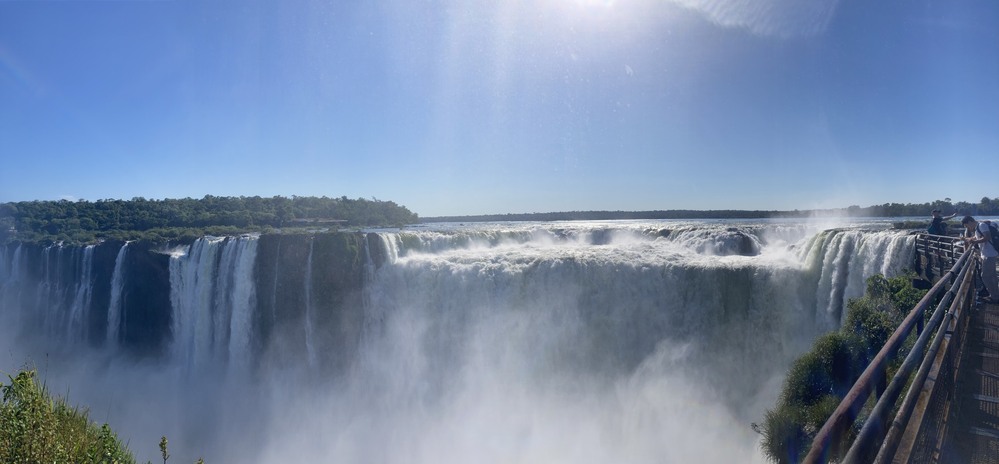
If you want to experience the falls from atop, that’s on the Iguazu Falls Argentina Side.
It’s hard to understand the sheer power and enormity of the falls from ground level. Here on the Argentinian side and a view from the top, you will understand why Iguazu holds the title for the greatest average annual flow of water in the world.
Fair warning, you’ll get a little mist, which means you will get wet near to Devil’s Throat. Pack waterproof protection for your camera gear.
Save time and money and consider a 2-day tour that takes you to both sides of the Falls. See prices and availability here.
Which Has Better Access to Iguazu Falls?
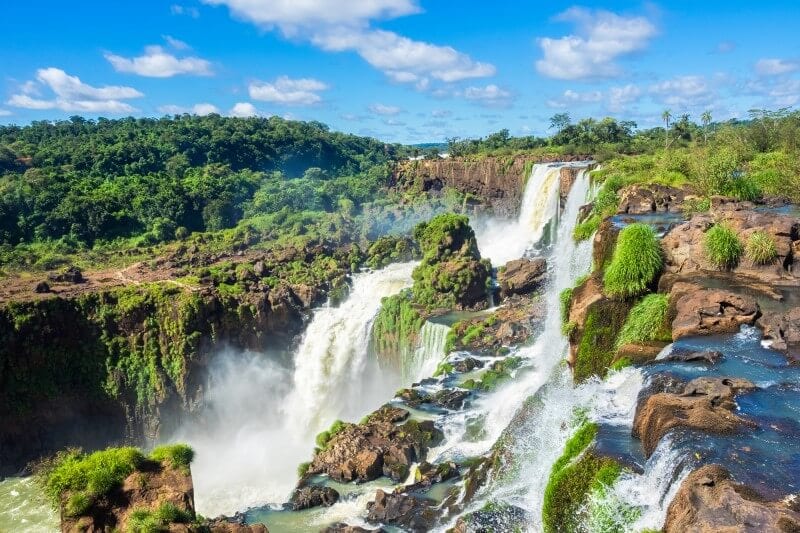
Mobility and the amount of walking involved is a big factor when deciding which is better to visit. The good news is, both sides offer an experience for those with mobility issues.
Access on the Brazil Side
At Brazil Iguazu Falls, you have the choice of walking or taking a bus to the viewing platform, in which there is an elevator that takes you down to the boardwalk.
The other option is to get off the bus at the start of the walkway and walk, but this is a 30 minute walk (longer when you stop to take photos) with some steps and ups and downs, so not good for wheelchair users, though children without strollers will be fine.
Access on the Argentina Side
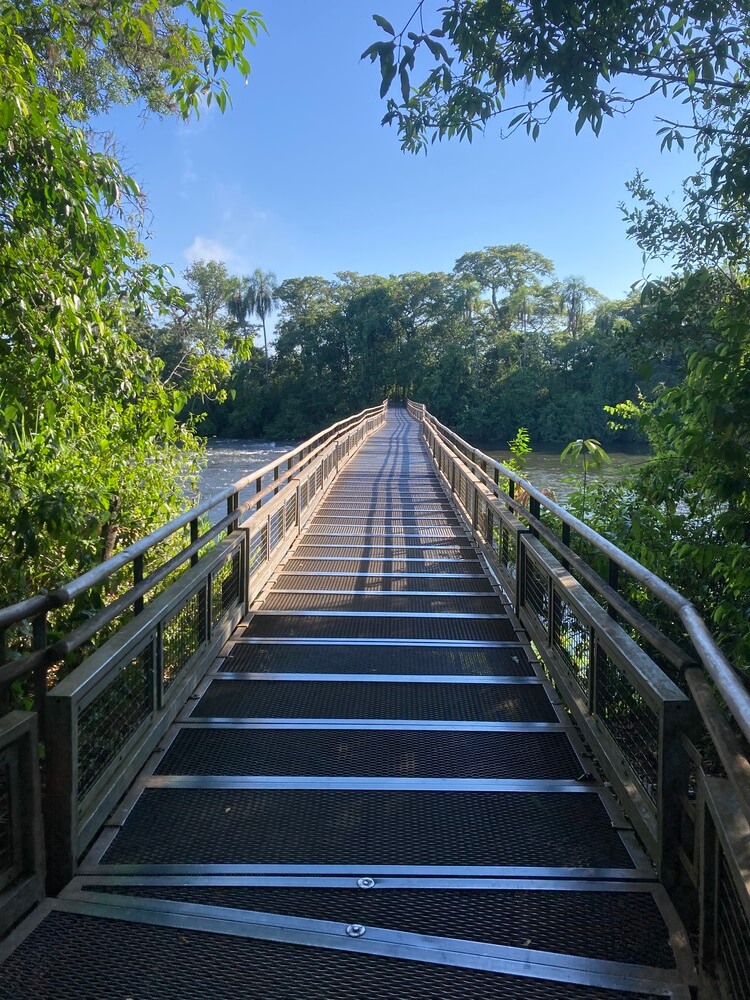
If you’re traveling with family and/ or persons with disabilities, the Argentina side is more equipped for your needs. With built in catwalks over dirt and gravel, the Argentinian side is definitely more pedestrian friendly. The steel trails and bridges makes getting to the falls easily accessible for all ages.
The Argentinian side has a train system with (3) main stations ; Estacion Central (at the entrance of the park), Estacion Cataratas (lower circuits) and Estacion Garganta del Diablo (upper circuit to Devil’s Throat) allowing for easy transport to different viewing points of the falls so your walk is minimal.
You can take a train from the entrance to the Devil’s Throat and then take a short 10 minute walk along a flat boardwalk from the station to the falls.
Most of the other trails on the Argentina side are wheelchair or stroller friendly, but not all of them. When you buy your ticket, you are given a helpful map which shows the accessible routes for wheelchair users.
If you’re deciding which is better for access, they are both accommodating, but I think the Argentina side has more options for those with reduced mobility to see.
Which Is Better for Wildlife at Iguaçu National Park?

If you’re deathly afraid of insects and bugs, the Iguazu Falls Brazil side is not for you. We were nearly eaten alive during our jungle ride through the forest and water boat ride.
However, if you love birds (like we do), visit Parque du Aves on the Brazilian Side. The bird park is not located within the Iguazu Falls’ premises.
It’s a completely separate park conveniently located across the street! Completely worth a trip back (and the extra stamps in our passports) to the Brazil side.
If you enjoy wildlife, the Argentinian side has more jungle to explore, where you have the channce to spot exotic birds and butterflies, not to mention daytime raccoons for no additional cost!
They’re everywhere so be on the lookout.
On both sides of Iguazu, the subtropical rainforest is home to many species of wildlife. You may spot tapirs, giant anteaters, and howler monkeys. And on a more rare occasion, ocelots, jaguars and caymans can be seen in the area.
Which Is Better for Things to Do at Iguazu Falls
When deciding which side to visit, the attractions and things you can do will be a huge factor in making this decision. Here’s a list of the attractions you can do on each side to help you know what to expect.
1. Boat Ride to the Falls

The water boat ride to the falls can be done on both sides, but is best seen and experienced from the Iguazu Falls Brazil side. The boat takes you through the canyon and under some of the mightiest falls, but it does not go to the iconic Devil’s Throat.
Before taking a boat ride, you should also know:
- It costs $150-$170 per person, not matter which side of the falls you take.
- If you take the boat from Brazil, there is a jungle bus ride before you reach the boat.
- You’re not going to get wet. You’re going to get drenched!
- Rain ponchos are useless.
- Keep an eye out for crocodiles and turtles, there are known to be a few in the waters.
2. Ziplining & Rappeling
You can rappel down the waterfall, zip-line through the jungle on the Argentinian side.
We did neither for lack of time but we hear it’s great fun.
3. Stand Next to Devil’s Throat (Start of the Falls)
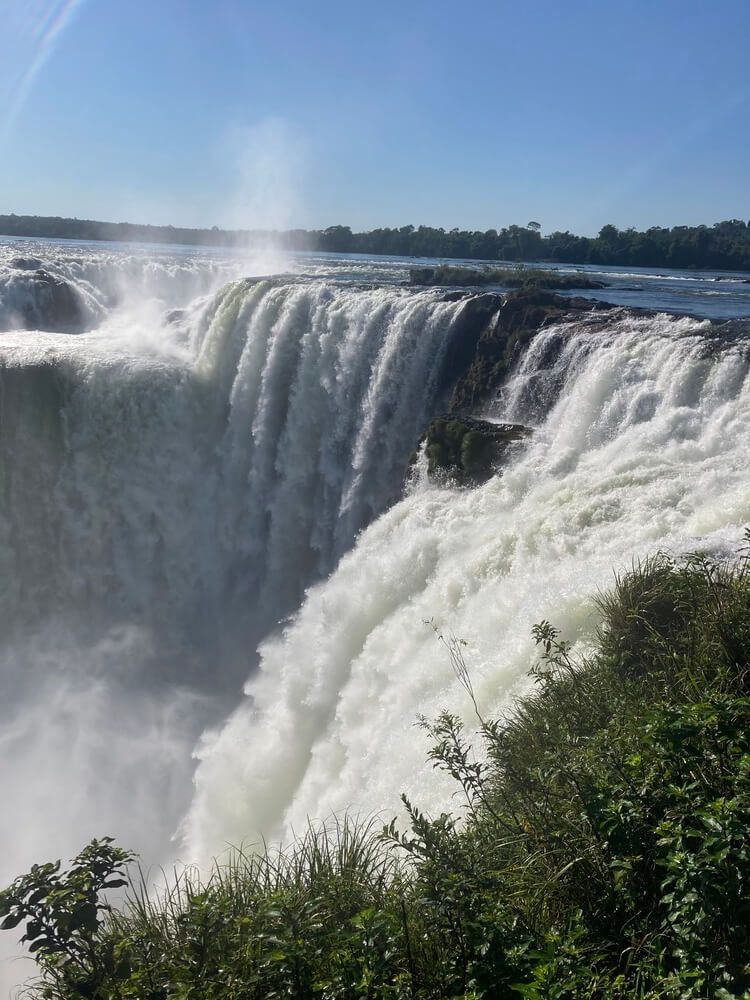
This is only available on the Argentina side, but you can walk all the way to the first and the tallest fall, known as Devil’s Throat. There is a viewing platform that sits right next to the falls, and is the closest you can get to the falls.
However, there is so much spray that all you can really see if a big mist of water. So if you’re looking to take good photos, it’s not the best spot for photography.
Seeing Devil’s Throat is pretty cool as you get to experience all that water rushing over the edge, falling 80 meters to the river below. This is the best place to experience the power of the falls.
But I also consider the walk to Devil’s Throat an activity in itself. You can take a train all the way to Devil’s Throat from the entrance, but the walk only took us 45 mintues and it was nice to wander through the jungle and see all the native plants and fauna.
4. Iguazu Falls Hiking Trails
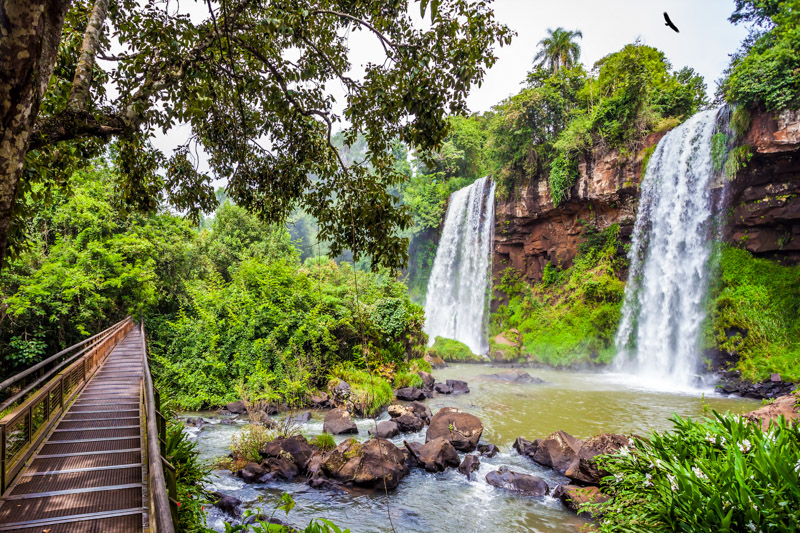
If you enjoy a good hike, the Brazil side is for you. It’s approximately a slow 40-minute hike to the falls. The hike was relatively easy, with minimal steps and uphill trek. I’m not much of a hiker but this was doable in my books.
Plus, when you hike, you get to see a lot of smaller falls along the trails. Perfect photo opportunity virtually every step of the way.
If you’re not a hiker by nature or have trouble accessing uneven trails and steps, you can stay on the double-decker bus and it will take to all the way to the end where you can take the elevator down to see the falls (no hike!).
5. Check out the Viewing Platforms
On both sides, there are several viewing platforms of the falls. On the Brazil side, there is really only one major platform, the others are simply viewpoints along a path that takes you to the falls.
The Argentina Side does have more viewpoints of the actual waterfalls of Iguazu.
Iguazu actually has 275 waterfalls or cataracts, and covers a 2.7 kilometers area. On the Brazil Side, the viewing platform allows you to look over many of the falls in one sweeping panoramic view – like this one!

On the Argentina side, you have several platforms that show you the smaller falls, as opposed to this massive site that you see in Brazil.
In Argentina, the views look a little more like this.
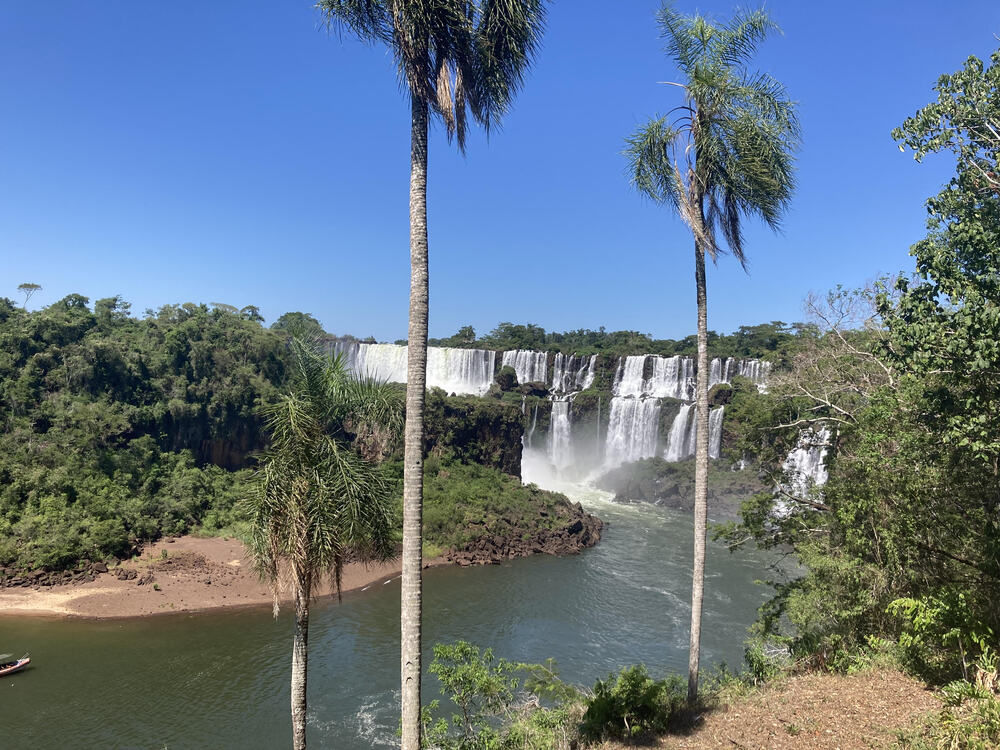
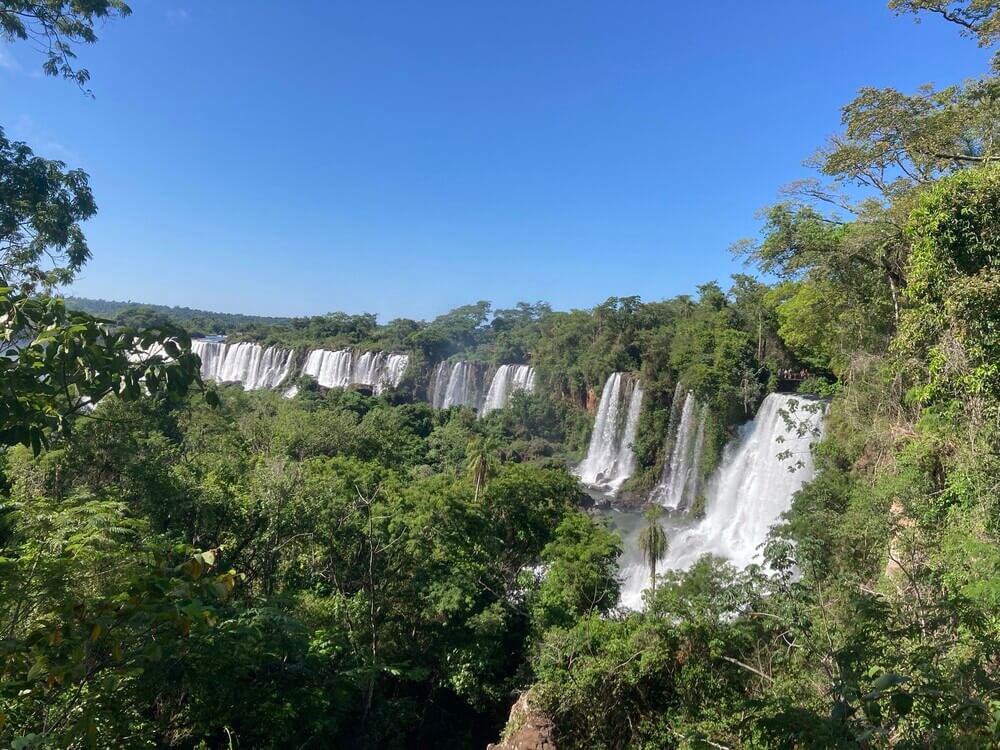
The views are still beautiful and as you can see, the waterfalls are still impressive. But it’s just a little underwhelming if you see the Argentina side after the Brazil side.
Park Entrance Fees
The cost is another big factor when deciding on which side to visit. Visitors can expect to pay more than the locals, of course, but the park entrance fees (as of March 2023) for both sides are as follows:
- Brazil side: 86.00 Real (about $16.50 USD) per person
- Argentina side: 4.675,00 ARS ($27.35 USD) for adults and $ 1.700,00 ARS ($8.64 USD) for children
- about $32 USD (though if you take cash out using Western Union you can save up to 50%)
We recommend you book your ticket in advance online, as both Brazil and Argentina have timed entry to limit the amount of people visiting at one time. If you visit at the weekend you will likely have to wait.
You can buy your ticket at the entrance, but the Argentina side does not accept credit card, only cash.
Other Things to Consider About Visiting Iguazu Falls
When choosing which is the best side to visit that Iguazu waterfalls, here are some other facts to consider…
- The helicopter ride is only available on the Brazil side.
- Rainbows — single or double — are best seen on the Argentine side.
- The climate varies on either side of the falls. Bring water and bug repellent for Brazil, and a hat and sunscreen for Argentina.
- Puerto Iguazu (Argentina) is cash only!
- The falls are quite far away from the town on the Argentina side and it takes about an hour on the public bus to get there.
- Outside the rainy season, the falls are not as impressive. From November to March (rainy season), you can see up to 450,000 cubic feet (12,750 cubic metres) of water falling per second, but in dry season (May – September), the flow is only around 62,000 cubic feet (1,756 cubic metres) per second.
Now that you have the facts, we have one question for you: are you Team Argentina or Team Brazil?
Check out this transport and entrance ticket combo for the Argentina side.
The Verdict: Which side of Iguazu Falls is Better?
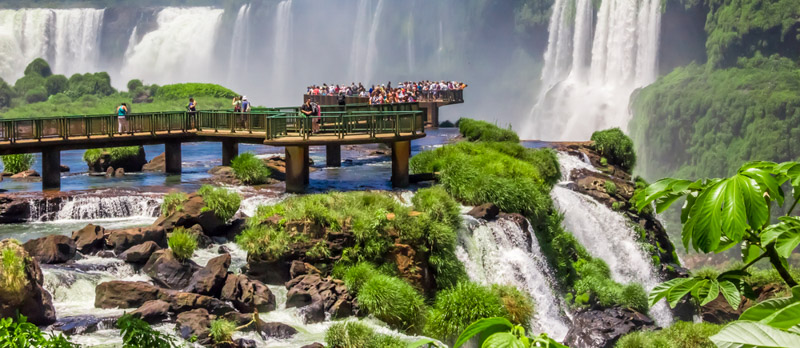
The truth is, both sides of the waterfalls of Iguazu are worth seeing as they offer different perspectives of the falls. The landscape is vastly different, and the falls are so impressive you will want to see them twice anyway.
But if you only have time for one, then the Brazil side is better for views, but the Argentina Side get closer to the falls.
The Brazil Side may have given us the best shot from the entire trip, but it doesn’t beat the experience with the Argentina Side.
The Argentinian side had a lot more to offer in terms of attractions as well. It has comfortable trails, different viewing points to visit and numerous activities to choose from.
Plus, double rainbows and colorful butterflies are far better than giant mosquitoes and spiders!
Bio: We’re Gerard and Kieu from GQtrippin.com! To sum our story in short, G’s job quit him and I (Q) am taking a career break to travel (half) the world — New Zealand, Australia and Asia to be exact.
The journey starts December 27, 2011 and we can’t wait! Join us for travel adventures and great indulgences across the globe. Do say hi to us on twitter or facebook.
More South America Travel Tips
Are you planning a bigger South America trip? Then you may find these other guides useful!
- 15 Unmissable things to do in Rio De Janeiro
- 20 of the best places to visit in South America
- Would you visit South America with a baby?
- 4 awesome experiences in South America to rave about
- 5 Places to Visit in Bolivia, South America
- A 10 day itinerary of Peru
- Sandboarding in Peru
- 11 Things you need to know before visiting Colombia